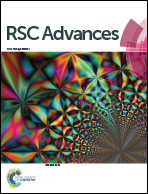A comparative study on the efficacy of different probes to predict the photo-activity of nano-titanium dioxide toward biomolecules†
Abstract
TiO2 is a reactive material able to cause the degradation of organic molecules following activation by UV light. This reactivity may be useful, e.g. in environmental or medical applications, but undesired when TiO2 is used as a UV filter in cosmetics and composites since it reduces the photo-stability of the material, and represents a possible pathway of injury. Conventional methods to measure the photo-activity of TiO2 include the degradation of small molecules or dyes. However the suitability of these methods to predict the photo-activity of TiO2 in biological systems is uncertain. This is the first product of a study, conducted within the FP7 EU project SETNanoMetro, that has as a main goal the standardizations of protocols to assess the oxidative potential of TiO2 nanopowders in biofluids. Here, the ability of a series of nano-TiO2 powders exhibiting different crystalline phases to degrade rhodamine B, a dye commonly used in photo-catalysis, and two model biomolecules (linoleic acid and 2-deoxyribose) under simulated sunlight was compared. Electron paramagnetic resonance (EPR) spectroscopy associated to different spin-probes or spin-traps was used to elucidate the reactive species involved in the processes. The results show how the photo-efficiency of TiO2 is affected by the kind of probe and by the presence of species that adsorb at the surface of the nanoparticles underlining the need of appropriate standard operating procedures (SOP) to evaluate the oxidative damage potential of semiconducting nanomaterials.


 Please wait while we load your content...
Please wait while we load your content...